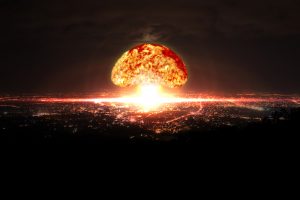‘The catastrophic results of the current conditions will impact generation upon generation’ – Hazrat Mirza Masroor Ahmad (aba)

Musa Sattar, UK
After the attack on Ukraine’s power plant; newspaper headlines on the current world crisis are turning the nightmare of a nuclear threat into a potential reality. Flashpoints have threatened to erupt into full-scale war. A tangible fear is that what we are witnessing today could, at any moment, escalate into a global catastrophe.
The dire consequences of such calamity extend far beyond our imagination. A nuclear strike would unleash suffering on a scale that history has never witnessed. Scientific studies support that devastating magnitudes of a possible nuclear war would not be limited to the targeted area, but will kill hundreds of thousands of people across the globe. As renowned scientist of our time, Albert Einstein remarked, ‘General annihilation beckons.’
The Ukraine-Russia crisis has the potential to spiral out of control involving other nuclear armed ‘super powers’. And if this happens, our children and future generations will face the lethal aftermath of destructive weapons used in such warfare.
Do we really want this horrendous legacy to be left for our children and generations to come?
Here, I will briefly touch upon scientific research done on short- and long-term effects of nuclear war, particularly its implications on the youngest members of the population.
Scientific Studies from Historical Tragedies
The historical facts are well documented. From the dreadful tragedies of Hiroshima, Nagasaki, to Chernobyl and Fukushima nuclear crises, scientific studies demonstrate the damage that a nuclear arsenal can cause to the human race.
In 1945, the people of Hiroshima and Nagasaki were hit by atomic bombs and suffered from numerous health problems due to the damage not only from the blast and heat (or fire) but also from radiation.
A long-term follow-up study of 120,000 atomic bomb survivors was published in the journal Maturitas. This study showed that the each 1 Gray of radiation (1Gy) exposure increased the risks of death by 22%, cancer incidence by 47%, leukemia death by 310%, as well as significantly increasing the incidence of several non-cancer diseases (such as thyroid nodules, chronic liver disease and cirrhosis, uterine myoma, and hypertension). Radiation exposure also significantly affected the growth of those participants who were between ages 5-15 years old at the time of the bombing. In women radiation exposure was associated with many gynaecological problems including early menopause.

Several other studies of the survivors of the atomic bombs in Japan has revealed the true horror that accompanied the survivors and their children. Children who were in the womb during the bombing and were exposed to radiation in utero had increased cancer rates and significant growth retardation including reduction in height, body weight, and chest circumference as an adult. In fact, the risk to the offspring never disappeared and children born up to 38 years after their parents were exposed to the atomic bomb had an increased risk of both cancer and non-cancer death.
In 1955, several scientists and a group of intellectuals issued a manifesto known as Russell-Einstein manifesto in which they stated,
‘Here, then, is the problem which we present to you, stark and dreadful and inescapable: Shall we put an end to the human race; or shall mankind renounce war?’ They further emphasised that, ‘People scarcely realize in imagination that the danger is to themselves and their children and their grandchildren, and not only to a dimly apprehended humanity.’
According to a research published in Lancet, the Fukushima accident also resulted in the release of large amounts of radioactivity, and in exposure of the surrounding population to a combination of irradiation and contamination.
In his research published in Journal of Surgical Oncology, Professor E.D Williams at Strangeways Research Laboratory Cambridge, suggested the unprecedented tragedy at the Chernobyl power plant in northern Ukraine showed a dramatic rise in thyroid cancer.
A collaborated research by Human Cancer Studies Group in Imperial College London, Institute of Endocrinology in Ukraine, Federal State Institution Medical Radiological Research Centre of the Russian Ministry of Health and Social Development in Russia, and Memorial Sloan-Kettering Cancer Center in New York, published in the Journal of Oncology, suggests that even relatively low doses of radiation received by children younger than 5 years old after Chernobyl were associated with a rise in thyroid cancer.

War Trauma – Psychological and Neurological Implications
The trauma of war lies deep within societies and transcends generations. There is consistent evidence of higher rates of trauma-related psychological problems in children in war.
‘Defenses against intolerable emotion such as anxiety of fear, hopelessness and rage are often seen most transparently in children,’ wrote Henry David Abraham, M.D. whilst explaining the consequences of arms race in his paper Inching Toward Armageddon: A Psychiatric View, published in The Yale Journal of Biology and Medicine.
According to studies published in The BMJ, Children in armed conflict areas experience high rates of mental disorders, including PTSD, depression, anxiety, behavioural problems, and attention deficit hyperactivity disorder, as well as functional impairment.
Physical Disabilities and Genetic Effects
Millions of children are killed by armed conflict, but three times as many are seriously injured or permanently disabled by it. According to WHO, armed conflict and political violence are the leading causes of injury, impairment and physical disability and primarily responsible for the conditions of over four million children who currently live with disabilities.
Some studies suggest that generations of children of those exposed to radiation fallout are statistically more likely to be born with crippling physical or intellectual disabilities.
According to research published by in Radiation and Environmental Biophysics, pregnant women who are victims of even lower levels of nuclear radiations are likely to miscarry or give birth to babies with a range of abnormalities and childhood leukemia.
Similarly, findings by research published in Nature suggests that infants exposed in utero to ionizing radiation from the Chernobyl accident had 2.6 times the incidence of leukaemia compared to unexposed children, and those born to mothers residing in regions with high radioactive fallout were at higher risk of developing infant leukaemia.
Need of the Hour – An End in Sight
To avoid annihilation, we must change our thinking which justifies war as necessary for the survival of our way of life; to a new thinking which recognises war as the ultimate threat to survival of our species.

In 2019, His Holiness, Hazrat Mirza Masroor Ahmad (aba), Fifth Caliph and Worldwide Head of the Ahmadiyya Muslim Community warned the global leaders of intensifying global hostilities and the risk of disastrous nuclear war. His Holiness (aba) said:
‘If there is a nuclear war, we will not only be destroying the world today but we will also be leaving behind a lasting trail of destruction and misery for our future generations. Hence, we must pause and reflect on the consequences of our actions. We should not consider any issue or conflict, whether within a country or at an international level, to be insignificant.’
Similarly, in his letters to world leaders in 2020, His Holiness (aba) wrote:
‘… humanity must urgently turn its attention towards God Almighty so that it may be saved from further misery and potential destruction.’
On another occasion, addressing the devastating consequences of a nuclear war and the critical need for absolute justice, His Holiness (aba) said,
‘… it is my ardent wish and hope that the leaders of all major nations come to understand this dreadful reality, and so instead of adopting aggressive policies and utilising force to achieve their aims and objectives, they strive to adopt policies that promote and secure justice… Time is running out, and before it is too late we must all pay great heed and attention to the needs of the time.’
About the Author: Musa Sattar has an MSc in Pharmaceutical Analysis from Kingston University and also serves as the Assistant Manager of The Review of Religions and the Deputy Editor of the Science & Religion section.



Add Comment